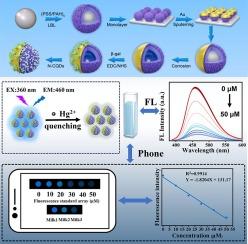基于β-半乳糖苷酶驱动胶体马达的牛奶中Hg2+的超灵敏快速检测
IF 8
1区 农林科学
Q1 FOOD SCIENCE & TECHNOLOGY
引用次数: 0
摘要
在这项研究中,我们提出了一种新的β-半乳糖苷酶驱动的Janus胶体马达,用于主动和快速检测牛奶中的Hg2+。在自组装的聚电解质胶囊的一侧沉积薄金层,在聚电解质胶囊的另一侧不对称地固定β-半乳糖苷酶和氮掺杂碳量子点,从而制备胶体电机。金侧表面的β-半乳糖苷酶能将牛奶中的乳糖分解为葡萄糖和半乳糖,导致主动运动。此外,由于胶体电机表面的氮掺杂碳量子点可以被牛奶中的Hg2+淬灭,因此这种胶体电机可以作为一种有效的荧光传感平台,用于Hg2+离子的灵敏检测。得益于胶体马达的高效运动,氮掺杂碳量子点与淬火衬底之间的相互作用大大增强,从而提高了Hg2+的检测效率和精度。在优化条件下,胶体马达的线性检测范围为0.031 ~ 15 μM,低检出限为9.1 nM。胶体马达被证明是一个有吸引力的多功能传感器平台,为监测乳制品中的Hg2+污染提供了一种有价值的手段。本文章由计算机程序翻译,如有差异,请以英文原文为准。

Ultrasensitive and rapid detection of Hg2+ in milk based on β-galactosidase driven colloidal motors
In this study, we present a new β-galactosidase-powered Janus colloidal motor for the active and rapid detection of Hg2+ in milk. The colloidal motor was fabricated by depositing a thin gold layer on one side of the self-assembled polyelectrolyte capsule, followed by immobilizing β-galactosidase and nitrogen-doped carbon quantum dots asymmetrically on the other side of the polyelectrolyte capsule. β-Galactosidase on the surface of the gold side can decompose the lactose in milk into glucose and galactose, leading to active motion. Furthermore, since nitrogen-doped carbon quantum dots on the colloidal motor’s surface can be quenched by Hg2+ in milk, such colloidal motors are found to serve as an effective fluorescent sensing platform for the sensitive detection of Hg2+ ions. Benefiting from the efficient movement of the colloidal motors, the interaction between the nitrogen-doped carbon quantum dots and the quenched substrate is greatly enhanced, thus improving the detection efficiency and accuracy of Hg2+. Under the optimized conditions, the colloidal motors achieved a linear detection range of 0.031–15 μM and the low detection limit of 9.1 nM. The colloidal motors are proving to be an attractive multifunctional sensor platform, providing a valuable means of monitoring Hg2+ contamination in dairy products.
求助全文
通过发布文献求助,成功后即可免费获取论文全文。
去求助
来源期刊

Food Research International
工程技术-食品科技
CiteScore
12.50
自引率
7.40%
发文量
1183
审稿时长
79 days
期刊介绍:
Food Research International serves as a rapid dissemination platform for significant and impactful research in food science, technology, engineering, and nutrition. The journal focuses on publishing novel, high-quality, and high-impact review papers, original research papers, and letters to the editors across various disciplines in the science and technology of food. Additionally, it follows a policy of publishing special issues on topical and emergent subjects in food research or related areas. Selected, peer-reviewed papers from scientific meetings, workshops, and conferences on the science, technology, and engineering of foods are also featured in special issues.
 求助内容:
求助内容: 应助结果提醒方式:
应助结果提醒方式:


